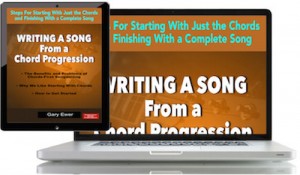Many songs will use the same chord progression in both the verse and the chorus, and of course it’s completely fine to do that. A classic example is America’s “A Horse With No Name”, which toggles back and forth between the two chords Em and D6-add9/F# for both verse and chorus. “Smells Like Teen Spirit” (Nirvana) is another good example.
For the songs that do use different progressions for verse and chorus, you need to know that there is no particular need to create a clever partnership between those two sections. Many songs use a verse progression that bears little to no resemblance to the chorus progression, like Lennon & McCartney’s “Penny Lane.”
 If you like the chords-first method of writing songs, you need to read “Writing a Song From a Chord Progression.” It shows you the advantages of this songwriting process, but also the problems you need to avoid. Comes with the 10-eBook Bundle, or purchase it on its own.
If you like the chords-first method of writing songs, you need to read “Writing a Song From a Chord Progression.” It shows you the advantages of this songwriting process, but also the problems you need to avoid. Comes with the 10-eBook Bundle, or purchase it on its own.
But there is a special advantage to creating a kind of partnership between the verse and chorus, and that advantage is that it adds a kind of “musical glue”, you might say, when we hear something similar but different.
Here’s a good example: if you used this as your verse progression: Am-C-Dm-G, repeated several times, and then you go on to a chorus progression that uses these chords: C-Dm-Am-G, can you tell what the connection is?
You probably guessed right: both sections use the same chords, but in a different order. While it’s not likely to be something the average listener is going to pick up on, that fact that the same chords are being used makes both sections sound similar, without actually using the same progressions.
That’s what I’d call a chord progression partnership. They add a similarity to the sound of your music when comparing verse and chorus, and it’s a similarity that your song could benefit from.
Looking for some more chord progression partners to try? Check out these ones:
Reversing Bass Line:
VERSE: C Dm C E F CHORUS: C G/B Am G F [Verse bass line moves up, chorus moves down]
Minor to Major:
VERSE: Am Em Am Em |Dm Am Dm Am CHORUS: C G C G |F C F C [Verse is mainly minor, chorus is mainly major]
Chords That Move Mainly By Thirds:
VERSE: C Em F Am |C Dm F Am CHORUS: C Am F Dm |C Am F Dm [Verse chords move up mostly by 3rds, chorus moves down mostly by thirds]
Chromatic Bass Line:
VERSE: F D/F# G E/G# A Bb G/B G7 CHORUS: C G/B Gm/Bb A G#dim C/G D/F# G [Verse ascends, chorus descends.]
Same Progression, Different Key:
VERSE: Cm Fm Ab G (repeat) CHORUS: Eb Ab Cm Bb [Verse in minor, chorus in major]
I’ll reiterate here that there is no particular rule or even a principle that states that there must be a harmonic connection between verse and chorus progressions; they can be completely different, with nothing in particular that binds them.
But I’ve found that for songs where you worry that you’re not hearing enough of a connection between the verse and the chorus (i.e., where the melodies and perhaps even the musical styles are very different), it might be a good idea to explore the possibility of connection by doing some kind of chord progression partnership similar to the five examples above.
 Written by Gary Ewer. Follow Gary on Twitter.
Written by Gary Ewer. Follow Gary on Twitter.
 Get “The Essential Secrets of Songwriting” eBooks. They’ll help you polish your technique, and make you the best songwriter you can be. Comes with a Study Guide, tons of chord progressions, and information covering every aspect of how to write good music.
Get “The Essential Secrets of Songwriting” eBooks. They’ll help you polish your technique, and make you the best songwriter you can be. Comes with a Study Guide, tons of chord progressions, and information covering every aspect of how to write good music.










